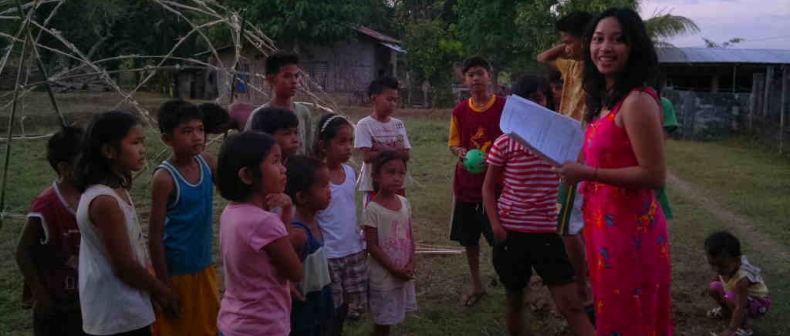
Artist rendition of the proposed solar plant in Tubao, La, Union, Philippines
Apocalypse Now, Francis Ford Coppola’s filmic reinvention of Joseph Conrad’s Heart of Darkness, was shot in the Philippines the year Toronto-based artist & filmmaker Irene Cortes was born. The terrible impact the film had on local populations stuck with her. She started production design for her film Nowhere Here Now, a sci-fi family adventure film based in an ecological utopia. Working closely with the local populations in the Philippines, she started building the sets, which consist of small-scale renewable solar energy plants. She hopes that the sets will remain as permanent structures that will provide energy for over 200 households.
Toronto Standard interviewed Cortes in advance of the June 16 launch of her Indiegogo campaign to rally support for the project.
TS: What is your film about?
Irene Cortes (IC): I’m responding to climate change while inspiring culture with a new, feel-good story to entertain our kids. Nowhere Here Now is a science fiction family adventure set in TRON-O, an ecological utopia where all the children have mysteriously fallen asleep. The film follows the mother of the only child left awake. When her child suddenly disappears, she sets out on a quest to find her missing child, and, in doing so, she discovers the root of TRON-O’s great suffering. The underlying message of the film is to listen to yourself, to spend time with your own mind, to test our limits by creating no harm and only peace – that’s the message.
TS: The filming of Apocalypse Now was a starting point for this work. Why?
IC: Apocalypse Now won a ton of critical acclaim, and it depicted a psyche of man that resonated. But in filming, they used real dynamite that disrupted forests. They built roads to ship strangers who then changed the land and its purpose. The village, which was once quiet, turned into a brothel. Male soldiers from Manila acting as extras controlled the villagers and morally corrupted their way of life. The real ‘horror the horror’ of Kurtz’s compound. And then leaving the sets there, that included bombed out villages, to produce a genre of filmmaking in the Philippines filled with gun violence, terrified villagers and misogyny for years to come. The roads were the lynchpin. The film built the infrastructure.
TS: You mention this film project has been 18 years in development. Can you explain how this came about?
IC: Eighteen years ago, I picked up my first motion picture camera: a Sony DVC camcorder. From then on, I’ve been thinking about how to make more movies and how they’re made.
TS: Where are you at now in terms of production?
IC: Right now, with Nowhere Here Now, I’m in pre-production. I’ve secured locations and partnerships.
TS: How are you working with local populations there?
IC: Tubao was home to my great-great-great grandparents. Electricity is really expensive there. The renewable energy is something that is really needed. I had a group of 12 women conducting surveys – we went to every house — over 700 families. We had a big town meeting. The mayor introduced my project and I got to speak about it. The houses have very little window space because glass is expensive, so they need to keep the lights on during the day, which is wasteful. Part of this project is a knowledge exchange on how to build better homes — everyone builds their own homes too. We are working with dialogue and options to better the conditions of the village. I built domes with kids there — it was really shocking to a lot of the builders because they’d never seen anything like that before — it was big, resilient, and kids were making it. It was mind-blowing to a lot of them. The kids that are being brought up in the village are now empowered to build in another way — because they will be building their own homes.
Shooting film with youth in Artes, SpainTS: What is the scope for the film sets?
IC: These sets would be considered small-scale power plants. Taking advice from IRENA (International Renewable Energy Agency), we’ll develop something inclusive with developing communities – a peace-building effort. And hopefully learn something ourselves.
TS: Will you use local materials and labour?
IC: It’s a big part of the process. Part of what my research involves looking at alternative organizational systems and mixing things up to experiment with inclusiveness, community building, and talking and choosing together to develop community power.
TS: Have you experienced any resistance to the project?
IC: No black lash from the locals, not from them. There’s been a lot of excitement, even jubilance. There has been some ‘critical support’, I guess. It’s kind of a sensitive issue in the Philippines to build renewable energy because there’s kind of strong mining lobbyists that mine silver, lithium, etc. They also want to create a mining industry similar to the tar-sands mining whatever minerals they could extract oil from. So the fossil lobby is quite strong in the Philippines. There’s a lot of corruption. I get a lot of warnings from people who want to support me but are afraid for their own position. I’m spinning it as building a set — a sci-fi set with the kids, teaching kids different skills, different approaches to building, vernacular architecture, all the while speaking English so they’re learning English. The higher political administrations are very happy with me going in that direction, but they don’t really want me to talk about renewable energy.
TS: How is your project similar to Juzcar (the Spanish town painted blue as a set for The Smurfs 3D, the world’s first official Smurf Village) in terms of community impact?
IC: It was really important for them to generate tourism and income for their town. It’s pretty neat looking. I think for the people there, I know from my experience with people in the smaller villages in the Phillipines, that maybe aren’t as cynical, they take pride in being part of a movie — in something bigger going on. So I can certainly see how that would boost the economy and village morale. It’s really exciting for them and I think it’s really great — the power of movie making is a universal thing. Anytime you see a big film crew there’s always curiosity. It’s big news. The village (Juzcar) is actually really beautiful.
TS: What is your intention with this work?
IC: I want the audience to come away with a sense of feeling like what they saw manufactured something in the real world. Our stories make what we see around us, and that can be really amazing. Part of making the film is to build sets that can be permanent power plants. It can give people a greater sense of what we can do, not only with filmmaking but in the stories that we tell. Imagination can materialize itself. I want people to know that they could do it themselves.
Dome building using local materials and with youth in Tubao, Philippines
A retrospective of Cortes work debuts at gallerywest (1172 Queen St. West): Irene Cortes: 1995- 2013 Exhibition: June 6 – 28, 2013. You can donate to Cortes’ Indiegogo campaign help fund Nowhere Here Now, or contact her directly.
____
Tiffy Thompson is a writer and illustrator for the Toronto Standard. Follow her on Twitter at @tiffyjthompson.
For more, follow us on Twitter at @TorontoStandard and subscribe to our newsletter.














